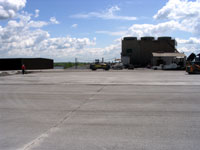 LAN Associates, an engineering consulting firm based in St. Augustine, Florida, recently selected roller-compacted concrete (RCC) for one of their industrial clients in the Midwest. The company needed a pavement that could economically cover large areas of at least 10 acres, and hold up to heavy-duty abuse from large equipment. This was a job particularly suited for RCC.
LAN Associates, an engineering consulting firm based in St. Augustine, Florida, recently selected roller-compacted concrete (RCC) for one of their industrial clients in the Midwest. The company needed a pavement that could economically cover large areas of at least 10 acres, and hold up to heavy-duty abuse from large equipment. This was a job particularly suited for RCC.
Dan Vipperman, project engineer for LAN Associates, did a thorough investigation of RCC before selecting it for the project.
“This is the first time we specified RCC for a project, so we needed to become familiar with the material and the design elements,” Vipperman said.
He worked with S&ME engineers at their Louisville, Tennessee, office to experiment with different mix designs. A dense-graded crushed stone aggregate was selected that had a nominal maximum size of ½ inch. The smaller aggregate gradation would provide a smoother surface for the heavy equipment and trucks that would be operating on the RCC.
Vipperman was also interested in a blended cement, since the surface of the RCC would be subjected to equipment scraping and needed to be especially durable. He eventually selected Teracem, a ternary cement supplied by Lafarge North America that is a blend of 75 percent portland cement, 20 percent slag cement, and five percent silica fume. He asked S&ME to investigate the effect that the Teracem might have on the compaction of the RCC, and found that the mix was slightly more sensitive to changes in moisture content than straight portland cement.
The mix design selected for the job used 13 percent Teracem at an optimum moisture content of 6.4 percent. This mix provided compressive strengths of 5,500 pounds per square inch (psi) in seven days, and 8,000 psi in 28 days.
 LAN Associates performed the pavement design with the assistance of PCA’s RCCPave computer program. Vipperman wanted to keep the construction to one lift in order to simplify the construction process. The original designs for RCC on subgrade called for approximately 11 inches of thickness, which is excessive for one-lift construction. An alternative of nine inches of RCC over four inches of cement-treated base (CTB) proved to be adequate, and since the nine-inch thickness could be placed in one lift this design was selected. For the CTB, a dense-graded aggregate with four percent Teracem provided 1,000 psi compressive strength in seven days.
LAN Associates performed the pavement design with the assistance of PCA’s RCCPave computer program. Vipperman wanted to keep the construction to one lift in order to simplify the construction process. The original designs for RCC on subgrade called for approximately 11 inches of thickness, which is excessive for one-lift construction. An alternative of nine inches of RCC over four inches of cement-treated base (CTB) proved to be adequate, and since the nine-inch thickness could be placed in one lift this design was selected. For the CTB, a dense-graded aggregate with four percent Teracem provided 1,000 psi compressive strength in seven days.
Using CTB for a RCC pavement is not new, and contractor A.G. Peltz of Birmingham, Alabama, has used it extensively.
“We used CTB under a lot of the RCC we placed at the Honda manufacturing plant in Alabama” said Ron Peltz, a partner with the construction company. “It is pretty economical to place, and it provides a great platform for RCC paving.”
Approximately one million square yards of RCC was placed at Honda, one of the largest RCC projects in North America.
 LAN Associates contracted with A.G. Peltz for construction of their industrial project, and work began in March, 2005. Peltz set up an Aran pugmill on site, and a nearby Vulcan Materials quarry provided the aggregate. Initial cylinders taken during construction had three-day compressive strengths of 3,400 psi, so the material performed as expected.
LAN Associates contracted with A.G. Peltz for construction of their industrial project, and work began in March, 2005. Peltz set up an Aran pugmill on site, and a nearby Vulcan Materials quarry provided the aggregate. Initial cylinders taken during construction had three-day compressive strengths of 3,400 psi, so the material performed as expected.
RCC Case Histories
Click here for more RCC case histories.